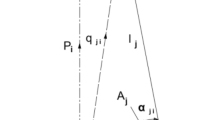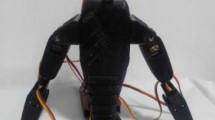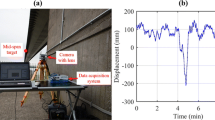Abstract
In recent years, a great deal of research is conducted to improve the accuracy of manipulator kinematic calibration of which the product of exponential formula (PoE) is used to represent the manipulator kinematics, whose purpose is to solve the singularity problem of the Denavit-Hartenberg (D-H) parameters. However, the noise sensibility is still an open problem since a matrix inverse calculation of Jacobian matrix is inevitable during the process of solving the kinematic-linearized-equations to obtain the calibrated parameters. This problem may causes non-convergence, or low-accurate solution of calibration algorithm if the environmental noises and the error of endeffector’s actual frame measurement techniques are considerable. This paper presents a kinematic calibration method using singular value decomposition least square algorithm based on the product of exponentials formula (SVD-PoE-least-squares algorithm) to improve the accuracy of calibrated parameters. The proposed algorithm is evaluated in simulation level using a 6-DOF puma 560-type manipulator. The obtained results have shown that SVD-PoE-least-square algorithm is insignificantly affected by environmental noises, and, the proposed method can complete the robot calibration with respect to the work frame directly.
Similar content being viewed by others
References
K. M. Lynch and F. C. Park, Modern robotics: Mechanics, planning, and control, Cambridge University Press, England (2017).
R. W. Brockett, Robotic manipulators and the product of exponentials formula, Proc. Int. Symp. Math. Theory of Networks and Systems, Beer Sheba, Isarel (1983) 120–129.
F. C. Park, Computational aspects of the product of exponentials formula for robot kinematics, IEEE Transactions on Automatic Control, 39 (3) (1994) 643–647.
K. Okamura and F. C. Park, Kinematic calibration using the product of exponentials formula, Robotica, 14 (4) (1996) 415–421.
S. Sastry and M. Bodson, Adaptive control: Stability, convergence, and robustness, Prentice–Hall, Englewood Cliffs, New Jersey (1989).
J. Moreno–Valenzuela and C. Aguilar–Avelar, Motion control of underactuated mechanical systems, Chapter 3, Spinger International Publishing AG, Cham (2018).
A. Filion, A. Joubair, A. S. Tahan and I. A. Bonev, Robot calibration using a portable photogrammetry system, Robotics and Computer–Integrated Manufacturing, 49 (2018) 77–87.
E. Shammas and S. Najjiar, Kinematic calibration of serial manipulators using Bayesian inference, Robotica, 36 (5) (2018) 738–766.
Keli et al., Optimal measurement for kinematic calibration of a six–DOF spatial robotic manipulator, 2017 IEEE International Conference on Real–time Computing and Robotics (RCAR), Japan (2017) 252–257.
P. T. Katsiaris, G. Adams, S. Pollard and S. J. Simske, A kinematic calibration technique for robotic manipulators with multiple degrees of freedom, 2017 IEEE International Conference on Advanced Intelligent Mechatronics (AIM), Germany (2017) 358–363.
H. Zhuang, Self–calibration of parallel mechanisms with a case study on Stewart platforms, IEEE Transactions on Robotics and Automation, 13 (3) (1997) 387–397.
W. Khalil and S. Bernard, Self–calibration of Stewart–Gough parallel robots without extra sensors, IEEE Transactions on Robotics and Automation, 15 (6) (1999) 1116–1121.
I.–W. Park, B.–J. Lee, S.–H. Cho, Y.–D. Hong and J.–H. Kim, Laser based kinematic calibration of robot manipulator using differential kinematics, IEEE/ASME Transactions on Mechatronics, 17 (6) (2012) 1059–1067.
D. J. Bennett and J. M. Hollerbach, Autonomous calibration of single–loop closed kinematic chains formed by manipulators with passive endpoint constraints, IEEE Transactions on Robotics and Automation, 7 (5) (1991) 597–606.
D. J. Bennett, D. Geiger and J. M. Hollerbach, Autonomous robot calibration for hand–eye coordination, International Journal of Robotics Research, 10 (5) (1991) 550–559.
W. S. Newman, C. E. Birkhimer, R. J. Horning and A. T. Wilkey, Calibration of a Motorman P8 robot based on laser tracking, Proceedings of the IEEE International Conference on Robotics and Automation (ICRA), USA (2000) 3597–3602.
A. Omodei, G. Legnani and R. Adamini, Three methodologies for the calibration of industrial manipulators: Experimental results on SCARA robot, Journal of Robotic Systems, 17 (6) (2000) 291–307.
A. Omodei, G. Legnani and R. Adamini, Calibration of a measuring robot: experimental results on a 5 DOF structure, Journal of Robotic Systems, 18 (5) (2001) 237–250.
G. Alici and B. Shirinzadeh, A systematic technique to estimate positioning errors for robot accuracy improvement using laser interferometry based sensing, Mechanism and Machine Theory, 40 (8) (2005) 879–906.
G. Alici, R. Jagielski, Y. Sekercioglu and B. Shirinzadeh, Prediction of geometric errors of robot manipulators with particle swarm optimisation method, Robotics and Autonomous Systems, 54 (12) (2006) 956–966.
J. O’Brian, R. Bodenheimer, G. Brostow and J. Hodgins, Automatic joint parameter estimation from magnetic motion capture data, Proceedings of Graphics Interface, USA (2000) 53–60.
P. Renaud, N. Andreff, J.–M. Lavest and M. Dhome, Simplifying the kinematic calibaration of parallel mechanisms using vision–based metrology, IEEE Transactions on Robotics, 22 (1) (2006) 12–22.
A. Rauf, A. Pervez and J. Ryu, Experimental results on kinematic calibration of parallel manipulators using a partial pose measurement device, IEEE Transactions on Robotics, 22 (2) (2006) 379–384.
S. K Mustafa, G. Yang, S. H. Yeo, W. Lin and I.–M. Chen, Self–calibration of a biologically inspired 7 DOF cabledriven robotic arm, IEEE/ASME Transactions on Mechatronics, 13 (1) (2008) 66–75.
H. Zhuang, Z. S. Roth and K. Wang, Robot calibration by mobile camera systems, Journal of Robotic Systems, 11 (3) (1994) 155–167.
P. Renaud, N. Andreff, F. Marquet and P. Martinet, Vision–based kinematic calibration of a H4 parallel mechanism, IEEE International Conference on Robotics and Automation (ICRA), Taiwan (2003) 1191–1196.
D. Daney, N. Andreff and Y. Papegay, Interval method for calibration of parallel robots: A vision–based experimentaion, International Workshop on Computational Kinematics, Italy (2005).
S. Hu, M. Zhang, C. Zhou and F. Tian, A novel selfcalibration method with POE–based model and distance error measurement for serial manipulators, Journal of Mechanical Science and Technology, 31 (10) (2017) 4911–4923.
P. Renaud, N. Andreff, M. Philippe and G. Gogu, Kinematic calibration of parallel mechanisms: a novel approach using legs observation, IEEE Transactions on Robotics, 21 (4) (2005) 529–538.
N. Andreff and P. Martinet, Unifying kinematic modelling, identification, and control of Gough–Stewart parallel robot into a vision–based framework, IEEE Transactions on Robotics, 22 (6) (2006) 1077–1086.
N. Andreff, P. Renaud, P. Martinet and F. Pierrot, Visionbased kinematic calibration of an H4 parallel mechanism: practical accuracies, Industrial Robot: An International Journal, 31 (3) (2004) 273–283.
Author information
Authors and Affiliations
Corresponding author
Additional information
Recommended by Associate Editor Joonbum Bae
Nguyen Van Toan received the B.S. degree in mechatronics from Center for Training of Excellent Students, Hanoi University of Science and Technology, in 2014. He researched at Korea Institute of Science and Technology, Seoul, Korea. His current research interests include robotics, fuzzy control, expert knowledge, artificial intelligence, hedge algebras, and genetic algorithm.
Phan Bui Khoi received his Doctorate degree in Robotics from Mechanical Engineering Research Institute of the Russian Academy of Sciences in 1997. He is Assoc. Professor of dynamics and control of robot and mechatronic systems at Hanoi University of Science and Technology. His current research, which focuses on robots applying in mechanical engineering and service, is concerned with dynamics of serial, parallel and cooperate robots, force control, fuzzy control; control of robots and mechatronic systems basing on artificial intelligence, hedge algebras and genetic algorithm.
Rights and permissions
About this article
Cite this article
Van Toan, N., Khoi, P.B. A svd-least-square algorithm for manipulator kinematic calibration based on the product of exponentials formula. J Mech Sci Technol 32, 5401–5409 (2018). https://doi.org/10.1007/s12206-018-1038-3
Received:
Revised:
Accepted:
Published:
Issue Date:
DOI: https://doi.org/10.1007/s12206-018-1038-3




